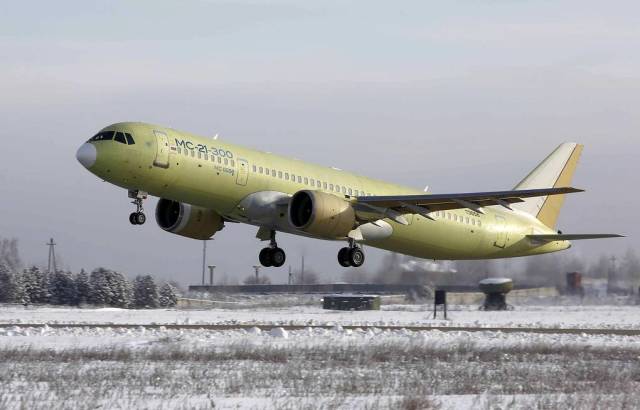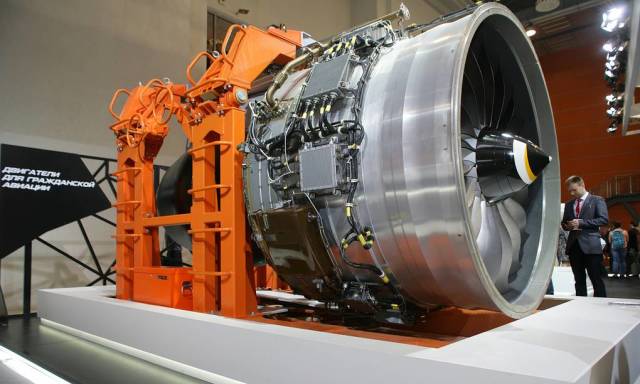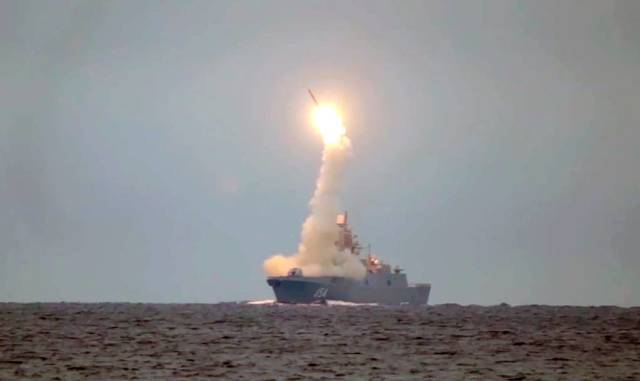Dmitry Litovkin - about the difficulties and success of the development of domestic industry, forced to reduce the supply of components from abroad

The aircraft MS-21-300
Image source: © press service of Irkut Corporation/TASS
New us sanctions, if imposed, may slow down one of the most ambitious and promising projects - the "mainline aircraft of the XXI century", the MS-21. The aircraft is currently undergoing testing and should go into production next year. This is promised by the head of the Ministry of industry and trade Denis Manturov. According to the Minister, "orders for 170 cars have already been made," while the first and main customer will be the state carrier Aeroflot, which will receive at least 50 such Airliners. But because of the new sanctions, the possibility of which is reported by the media, these plans can now "float", because American engines and on-Board equipment of Western production will then become inaccessible to us. Due to the previously imposed sanctions, Russia has stopped receiving composite materials from the United States and Japan that are necessary for the production of new aircraft wings.
Entering the foreign market
The aviation industry is probably one of the most critically dependent areas of the Russian economy on the West. In the early noughties, this trend was laid by the Sukhoi design Bureau, when it decided to create a medium-haul passenger airliner Sukhoi Superjet 100-a machine that is not original in essence, but clearly fits into the existing market niche. The world's major aircraft manufacturers, Boeing and Airbus, did not have aircraft of this size in their Arsenal, which gave a chance that the SSJ would be in demand by internal and external customers.
Confidence in this was reinforced by the fact that all the equipment-engines, hydraulics, avionics and much more - was taken from the"market". Sukhoi actually designed only the fuselage and integrated foreign components into it. The process was controlled by the same Boeing, whose specialists certified each stage of development. In General, it is clear why the head of the company, Mikhail Pogosyan, followed this scheme. At the time of starting work on the airliner, this was the only opportunity to build a passenger plane that could be painlessly and quickly certified according to Western flight safety standards, and therefore enter the foreign market.
The same Tu-334, which is constantly cited as an alternative to the Sukhoi product, would not have coped with this task. It would be impossible to certify a "Soviet" car according to Western standards. In terms of noise, economy, and a number of other parameters, it no longer corresponded to the time. Even if there were three people in the cab. And any Western plane has two of them.
But what is the result? Raised in 2008, the aircraft in 2020 is still 70% made up of foreign components. Including flying on a French engine. Our promising PD-8 engine, according to the first Deputy head of the rostec state Corporation Vladimir Artyakov, will at best receive a certificate for the SSJ-100 and be-200 amphibious aircraft in 2023. So Sukhoi is in a dual position: it can "fly" under sanctions, and because of them it can not pass certification according to the flight safety standards of the European aviation safety Agency (EASA).
The developers of the MS-21-Irkut Corporation-also did not invent the Bicycle. In the 1990s, 2000s, and even now, the company survived by producing su-30 fighters. At the moment, this is the most mass-produced combat aircraft in the world. According to open sources, at the beginning of 2018, more than 680 such cars were produced. They are operated in Algeria, Armenia, China, India and Russia. But the management of the Irkutsk plant pragmatically understood that the demand for military equipment would eventually end and a new vector of development was needed. This was the MS-21 project. At the same time, the manufacturer, as well as the Sukhoi company, understood that the main components of the aircraft must be imported, otherwise they would not get to the foreign market. Therefore, he paid for the development of Pratt & Whitney's new and" most innovative " PW1400 engine at that time. I bought American composites for the production of the "most efficient" wing, and so "little things" bought more different equipment.

PD-14 engine for MS-21 aircraft at the III international engine building forum "MFD-2018"
Image source: © Ladislav Karpov/TASS
The plane is beautiful, but it will hardly be able to fly in the near future. Even when the domestic PD-14 engine is installed on it. A car with this engine should start testing right now. After all, now we need to import American composite materials for the "new" wing and, perhaps, if the next package of sanctions against the manufacturer is introduced, solve the issue with avionics. And all this is re-checked and certified. Which will take a long time.
Success in engine building
Import substitution is the cornerstone of our industry now. After all, in the noughties, industry officials often relied on cooperation with the West. We planned to buy Italian Centaurus wheeled tanks from Iveco. The Navy confidently ordered two French large landing helicopter carriers of the Mistral type. At the Farnborough International Airshow in England, the then head of the Irkut Corporation, Alexey Fedorov, promised that the be-200 amphibious aircraft would receive Rolls-Royce engines.
The tanks simply did not fit the characteristics for use in the conditions of the Russian winter. In the cold, they froze all liquids, and movement on virgin land was limited to a half-meter layer of snow, which the Italian could not overcome. In 2014, the French refused to supply us with ready-made Mistrals because of us sanctions. We were able to lay our own analogues at the Zaliv plant in Crimea only this year. Be-200S are produced with Ukrainian engines.
However, the gap in relations with Ukraine after 2014, we still generally compensated. JSC "UEC " Klimov", part of the United engine Corporation (part of rostec), this year launched a series of production of aircraft engines of the TVZ-117 and VK-2500 family of engines in the amount of $ 1.5 billion. They were necessary for combat and transport helicopters Ka-31, Ka-32, Ka-52, Mi-8 of various modifications, Mi-24, Mi-28N, Ka-52 and Mi-35 and the promising light military transport aircraft Il-112B. At the moment, the plant is ready to produce up to 500 such engines per year. Ten years ago, the degree of localization of production of such equipment in Russia was only 10%. And this is despite the fact that Klimov was a scientific base-the developer of engine models for the serial Ukrainian plant Motor Sich, where all helicopter engines were produced in Soviet times.
This week, UEC-Saturn from Rybinsk also reported on its success. Thanks to his efforts, Russia finally got the opportunity to build a series of project 22350 frigates of the Admiral Gorshkov type - modern warships of the ocean zone, the production of which was actually frozen due to the termination of supplies of Ukrainian gas turbine power plants. The M55R engine has successfully passed qualification and acceptance tests. It is planned to be installed on the third ship of the Admiral Isakov series. As a result, we will get rid of dependence on the products of the Nikolaev enterprise "Zorya" - "Mashproekt" and will be able to build our ships without regard to sanctions. And not only the 22350 project, but also others.

Launch of a hypersonic cruise missile "Zircon" from the lead frigate of project 22350 "Admiral of the fleet of the Soviet Union Gorshkov", October 2020
Image source: © Press service of the Russian defense Ministry/TASS
The importance of this event is that it is the ships of project 22350 that will represent the country in the far ocean zone. Our main carriers of long - range Kalibr cruise missiles-Buyany and Karakurty-have limited navigation autonomy. Gorshkov-type frigates with new gas turbine installations will be much more efficient. Moreover, they are planning to build a new project. The letter m is prepared for him. In a nutshell, this means that instead of 16 universal 3C-14 launchers, the updated ships will get 24. They can be used to launch both long-range Kalibr cruise missiles, anti-ship supersonic Onyx missiles, and hypersonic Zircon missiles.
The Navy plans to receive at least 10-12 such ships. This will allow us to effectively carry out the tasks prescribed in the new naval doctrine, one of the symbols of which was the decision to open a naval base in Sudan, which provides Russia with access to the Indian ocean.
Pumps for submarines
Import substitution is a long and difficult process. The United engine Corporation had to spend ten years to create a replacement for Ukrainian products. Just as it took time to replace the pumping units on our newest nuclear submarines, project 955 of the Borey type and project 885 of the Yasen type. Previously, all Soviet and Russian boats were equipped with products of the Moldovan scientific and technical center "Hydrotechnika". The design of each boat has dozens of pumps, in fact-this is the heart and circulatory system of the submarine. They ensure the circulation of liquid in the reactor, surfacing and diving, filling the torpedo tubes with water before firing, and cooling the systems and equipment of submarines. The noise of their work is the main unmasking sign of a nuclear submarine. This is what the enemy's sonar stations hear.
New Russian products are silent. All pumps meet the fourth category of requirements for vibrohydraulic technology. This is the highest category of products. Only a few companies in the world produce such things. Their characteristics are considered top secret, since they determine the physical portrait of each specific submarine. Knowing these parameters, it can be easily detected against the background of natural ocean noises.
